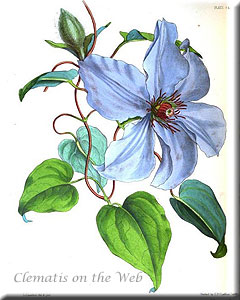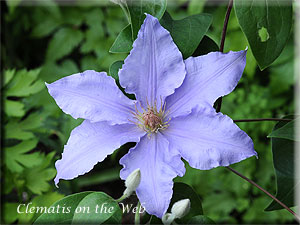
Image from Paxton's Flower Garden (1853)

Photo © 2010 Clematis on the Web

Bud - Photo © 2010 Clematis on the Web
Clematis lanuginosa
Very large flowered species form. The tepals can vary from pale lilac-blue through to white depending on the specimen. The stamens have white filaments and purple-red or pale yellow anthers. Introduced into England at Standish & Noble Nurseries in 1850 by Robert Fortune.
Paul Margot tells us, "The species is limited in its natural distribution to the province of E. Zhejiang (Chekiang) in China. Robert Fortune discovered it in 1850 in the hills near the town of Ningbo. He shipped a number of plants to England to the nursery of Standish and Noble in Bagshot, Surrey. The species was then described by Professor John Lindley and published in Paxton Flower Garden in 1853. The specimen described by Lindley as being azure (deep blue to purple) agrees with the colour description of purplish in the current Flora of China.
"Probably included in the same shipment were a paler blue form which was designated C. lanuginosa var. pallida and possibly a greyish blue form designated C. lanuginosa var. longipetala.
The name lanuginosa means hairy and refers to the woolliness of the flower buds, flower stalks and young leaves which characterises this species. It was widely used in breeding until the end of the 19th century and thereafter there is little reference to it. It appears no longer to be in cultivation."
The book plate image is reproduced from 'Google Books'.
| Approximate height: | 1.5 - 2.0 metres |
| Flowering period(s): | May Jun Jul (Aug Sep) |
| Aspect: | Any aspect |
| USDA zones: | 4 5 6 7 8 9 |
| Country of origin: | China |
| Parentage: | Species |
| Other name(s): | florida subsp lanuginosa; 'Lanuginosa Longipetala' |
| Further detail: | Flower diameter: (8-)12-20(-26)cm Tepals: 6(-8), 4-9cm long and (3-)7-8cm wide, broad, deeply overlapping, pointed, somewhat wavy, downy outside and along the margin Leaves: usually simple, occsionally ternate, hairy on the reverse |